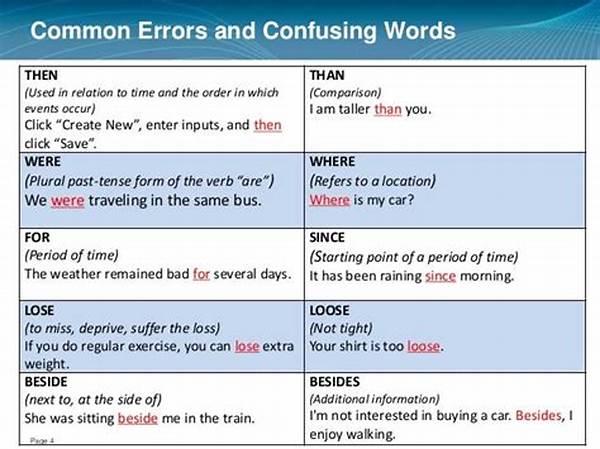Navigating the world of writing can sometimes feel like walking through a linguistic labyrinth, with verb tenses serving as signposts that guide readers through the timeline of events. Unfortunately, even seasoned writers can stumble upon common tense errors in writing, which can confuse readers and disrupt the flow of a narrative. Understanding and avoiding these errors is crucial to ensuring clarity and coherence in any written piece.
Understanding Common Tense Errors
Common tense errors in writing often arise from a lack of clarity about when an action occurred, whether it’s happening right now, or if it will happen in the future. A classic example is when writers mix past and present tense without a logical reason, leading to sentences that feel jumbled. Another frequent mistake involves using the wrong form of a verb, such as swapping past tense for past participle. Keeping a consistent tense helps maintain clarity, allowing readers to follow the timeline smoothly. Additionally, errors can emerge from not aligning verb tenses with time expressions used in the text. For example, pairing “yesterday” with present tense verbs is a mismatch that can easily be avoided with a bit of careful editing. Understanding these common errors is the first step toward mastering seamless writing.
Examples of Common Tense Errors
1. Shifting tenses mid-sentence is one of the most common tense errors in writing, leading to reader confusion.
2. Using the past tense when the present perfect tense is needed can obscure the intended meaning.
3. Common tense errors in writing include improper verb form usage, such as using “gone” instead of “went.”
4. Confusing the future tense with the present can result in ambiguity and misunderstandings.
5. Neglecting to match verb tense with the time expressions provided can confuse the timeline of events.
The Importance of Consistency
A key aspect of avoiding common tense errors in writing is maintaining consistency throughout your text. When the tense shifts without reason, it can pull readers out of the experience, disrupting the narrative flow. Consistent tense usage acts as an anchor, grounding your reader in the world you’ve crafted. To achieve this, consider your text’s overall perspective and timeframe before you start writing. Ask yourself whether the events are mostly past, present, or future, and adjust your verb tenses accordingly. Beyond consistency, it’s important to align the tense with the narrative intent. For instance, if you want to generate immediacy or intimacy, using present tense might be more effective. Conversely, past tense works well for recounting anecdotes or historical tales. Ultimately, the choice of tense should support the narrative, not hinder it.
Recognizing Different Types of Errors
Recognizing various common tense errors in writing involves understanding the subtleties of English grammar. Sometimes, errors occur due to the misplacement of auxiliary verbs, particularly in complex tenses like the present perfect continuous. Other times, writers might mix modal verbs with incompatible tenses, such as pairing “would” with present perfect. Further, incorrect sequence of tenses within a complex sentence can lead to awkward phrasing that confuses the reader. For instance, expressing a past condition with a future result requires precise tense alignment. Another type of error includes neglecting subjunctive mood rules, which might affect verb forms. Being aware of these pitfalls can help writers avoid them in their work. Familiarity with tense rules helps maintain clarity and ensures that the intended meaning shines through seamlessly.
Mastering Tense Fluidity
Mastering tense fluidity involves understanding when and why you might intentionally shift tense to enhance your writing. While it’s essential to avoid haphazard tense changes, strategic shifts can add depth and texture. Flashbacks, theoretical discussions, and imagined scenarios often require different tenses. For example, a narrative might unfold in the past but shift to future tense when a character anticipates what could happen. In persuasive writing, starting with present tense before transitioning to the future for proposed solutions can be engaging and effective. Similarly, reflection in memoirs often uses past tense before jumping to present tense as insights or lessons emerge. These transitions must feel intentional and seamless, providing clarity rather than confusion. To achieve this, practice is key. Write with purpose, and review your work with an eye for tense consistency to ensure your message resonates as intended.
The Role of Time Expressions
Time expressions play a crucial role in avoiding common tense errors in writing. Words like “yesterday,” “tomorrow,” and “currently” signal timeframes that should align with the verb tense used. Misalignment confuses readers and disrupts the narrative flow. Consistently pairing correct verb tenses with time expressions can enhance clarity and coherence. For example, “I will do it tomorrow,” “I did it yesterday,” and “I am doing it currently” all correctly match verb tenses to time expressions, guiding readers smoothly through the timeline. Awareness of this relationship is key to precise and fluid writing.
Conclusion
Common tense errors in writing are stumbling blocks for many, but they offer an opportunity for learning and refinement. Recognizing these errors, such as inappropriate tense shifts or mismatched time expressions, sets the foundation for improvement. With awareness and practice, writers can hone their ability to use tenses effectively, creating engaging, coherent narratives. Understanding and addressing these errors not only clarifies the intended message but also ensures a seamless reading experience. By continually refining tense usage, writers can enhance their communication skills, crafting stories and essays that resonate clearly with their audience. Ultimately, mastering tense unveils the power of language in guiding readers through time, bringing stories to life with precision and clarity.
